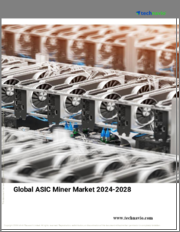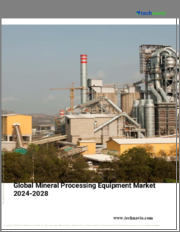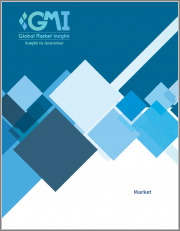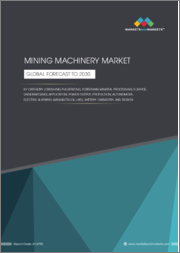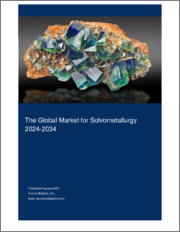
|
시장보고서
상품코드
1329011
세계의 Solvometallurgy 시장(2024-2034년)The Global Market for Solvometallurgy 2024-2034 |
||||||
코발트, 크롬, 갈륨, 게르마늄, 흑연, 인듐, 리튬, 망간, 몰리브덴, 니켈, 희토류, 텔루륨 등 채굴되는 중요한 광물 및 금속에 대한 에너지 및 하이테크 시장으로부터의 세계 수요는 계속 증가하고 있으며, 공급을 늘리고, 중국으로부터의 수입에 대한 의존을 줄이는 것이 매우 중요합니다. 2050년까지 세계 기후 목표를 달성하기 위해 30억 톤 이상의 새로운 광물 및 금속이 필요하게 될 가능성이 있는 저탄소 에너지의 미래에 이 재료의 장기적인 이용 가능성과 비용 안정성은 매우 중요합니다.
Solvometallurgy는 기존 프로세스와 비교하여 온실가스 배출, 에너지 사용, 폐기물 생산을 삭감하고, 금속 회수율을 향상시키며, 광석 및 폐기물 흐름으로부터 보다 높은 수율을 낮은 비용으로 달성하는 것에 기여할 수 있습니다. 시장의 발전은 향후 수요를 충족하기 위한 금속과 광물 추출 및 회수에서 중요합니다.
세계의 Solvometallurgy 시장에 대해 조사분석했으며, 기술 분석, 시장 촉진요인과 과제, 시장 규모 추산, 기업 개요 등을 제공하고 있습니다.
목차
제1장 조사 방법
제2장 용어와 정의
제3장 기술 분석
- 개요
- 기타 프로세스
- 사용 동기
- 주요 기술, 재료, 프로세스
- 비교 분석
- 용매 추출
- Bioleaching
- 염화물/염소 침출
- 초임계 유체 추출
- 이온성 액체
- 직접 용매 추출
- Heap Leaching
- 가압 산화 침출
- 마이크로파 가열
- 초음파 어시스트 침출
- 레진 인 펄프
- 전해 채취
- 기타
- 가공·추출되는 금속과 광물
- 구리
- 니켈
- 코발트
- 희토류 원소(REE)
- 리튬
- 금
- 우라늄
- 아연
- 망간
- 탄탈럼
- 니오븀
- 인듐
- 갈륨
- 게르마늄
- 안티몬
- 스칸듐
제4장 시장 분석
- 시장 현황
- 시장 참여 기업
- SWOT 분석
- 시장 맵
- 밸류체인
- 과거와 현재 시장 규모 추산
- 총매출(2019-2022년)
- 프로세스별, 기술별
- 지역별
- 성장 추산과 예측
- 추정 매출(2023-2034년)
- 프로세스별, 기술별
- 지역별
- 시장 촉진요인과 성장요인
- 시장이 해결해야 할 과제
제5장 기업 개요(38사의 개요)
제6장 참고 재료
KSA 23.09.14Solvometallurgy involves the use of solvents other than water for mineral processing and metal extraction. It can provide environmental and economic benefits compared to traditional processes like pyrometallurgy. With ever increasing global demand from energy and high-tech markets for mined critical minerals and metals such as cobalt, chromium, gallium, germanium, graphite, indium, lithium, manganese, molybdenum, nickel, rare earths, and tellurium, the need to both increase supply and reduce dependence on imports from China is of critical importance. Long-term availability and cost stability of these materials is critical for a low-carbon energy future that will potentially require over 3 billion tons of new minerals and metals to achieve global climate goals by 2050.
Solvometallurgy can contribute to lower greenhouse gas emissions, energy use, and waste production compared to traditional processes, improve metal recoveries and achieve higher yields from ores and waste streams, at a lower cost. The development of the global market for solvometallurgy will be crucial for the extraction and recovery of metals and minerals to meet future demand. Players in the market include start-ups, mining companies and chemical producers.
Report contents include:
- Technology analysis
- Description of other processes.
- Market drivers and challenges.
- Key technologies and processes including:
- Solvent Extraction.
- Bioleaching.
- Chloride/Chlorine Leaching.
- Supercritical Fluid Extraction.
- Ionic Liquids.
- Heap Leaching.
- Direct Solvent Extraction.
- Pressure Oxidation Leaching.
- Microwave Heating.
- Ultrasound-Assisted Leaching.
- Resin-in-Pulp.
- Electrowinning.
- Advanced materials
- Metal-Organic Frameworks (MOFs).
- Deep eutectic solvents.
- Nanoparticles.
- Carbon nanotubes.
- Conductive polymers.
- Bio-materials.
- Analysis of Metals and minerals processed and extracted including:
- Copper.
- Nickel.
- Cobalt.
- Rare Earth Elements (REE).
- Lithium.
- Gold.
- Uranium.
- Zinc.
- Manganese.
- Tantalum.
- Niobium.
- Indium.
- Gallium.
- Germanium.
- Antimony.
- Scandium.
- Commercial solvometallurgy market analysis:
- Current state of the market and future outlook.
- Market players.
- SWOT analysis.
- Market map & value chain.
- Historical and current market size estimates.
- Profiles of 38 companies. Companies profiled include BacTech, BASF, Berkeley Energia, EnviroMetal Technologies, Metso, PH7, Rio Tinto and Sumitomo Metal Mining.
TABLE OF CONTENTS
1. RESEARCH METHODOLOGY
2. TERMS AND DEFINITIONS
3. TECHNICAL ANALYSIS
- 3.1. Description
- 3.2. Other processes
- 3.2.1. Pyrometallurgy
- 3.2.2. Hydrometallurgy
- 3.2.3. Electrometallurgy
- 3.2.4. Aeriometallurgy
- 3.3. Motivation for use
- 3.4. Key technologies, materials and processes
- 3.4.1. Comparative analysis
- 3.4.2. Solvent extraction
- 3.4.2.1. Process description
- 3.4.2.2. Advantages
- 3.4.2.3. Challenges
- 3.4.3. Bioleaching
- 3.4.3.1. Process description
- 3.4.3.2. Advantages
- 3.4.3.3. Challenges
- 3.4.4. Chloride/Chlorine Leaching
- 3.4.4.1. Process description
- 3.4.4.2. Advantages
- 3.4.4.3. Challenges
- 3.4.5. Supercritical Fluid Extraction
- 3.4.5.1. Process description
- 3.4.5.2. Advantages
- 3.4.5.3. Challenges
- 3.4.6. Ionic Liquids
- 3.4.6.1. Process description
- 3.4.6.2. Advantages
- 3.4.6.3. Challenges
- 3.4.7. Direct Solvent Extraction
- 3.4.7.1. Process description
- 3.4.7.2. Advantages
- 3.4.7.3. Challenges
- 3.4.8. Heap Leaching
- 3.4.8.1. Process description
- 3.4.8.2. Advantages
- 3.4.8.3. Challenges
- 3.4.9. Pressure Oxidation Leaching
- 3.4.9.1. Process description
- 3.4.9.2. Advantages
- 3.4.9.3. Challenges
- 3.4.10. Microwave Heating
- 3.4.10.1. Process description
- 3.4.10.2. Advantages
- 3.4.10.3. Challenges
- 3.4.11. Ultrasound-Assisted Leaching
- 3.4.11.1. Process description
- 3.4.11.2. Advantages
- 3.4.11.3. Challenges
- 3.4.12. Resin-in-Pulp
- 3.4.12.1. Process description
- 3.4.12.2. Advantages
- 3.4.12.3. Challenges
- 3.4.13. Electrowinning
- 3.4.13.1. Process description
- 3.4.13.2. Advantages
- 3.4.13.3. Challenges
- 3.4.14. Other
- 3.4.14.1. Metal-Organic Frameworks (MOFs)
- 3.4.14.2. Deep eutectic solvents
- 3.4.14.3. Nanoparticles
- 3.4.14.4. Carbon nanotubes
- 3.4.14.5. Conductive polymers
- 3.4.14.6. Bio-materials
- 3.5. Metals and minerals processed and extracted
- 3.5.1. Copper
- 3.5.1.1. Global copper demand and trends
- 3.5.1.2. Markets and applications
- 3.5.1.3. Copper extraction and recovery
- 3.5.2. Nickel
- 3.5.2.1. Global nickel demand and trends
- 3.5.2.2. Markets and applications
- 3.5.2.3. Nickel extraction and recovery
- 3.5.3. Cobalt
- 3.5.3.1. Global cobalt demand and trends
- 3.5.3.2. Markets and applications
- 3.5.3.3. Cobalt extraction and recovery
- 3.5.4. Rare Earth Elements (REE)
- 3.5.4.1. Global Rare Earth Elements demand and trends
- 3.5.4.2. Markets and applications
- 3.5.4.3. Rare Earth Elemens extraction and recovery
- 3.5.4.4. Recovery of REEs from secondary resources
- 3.5.5. Lithium
- 3.5.5.1. Global lithium demand and trends
- 3.5.5.2. Markets and applications
- 3.5.5.3. Lithium extraction and recovery
- 3.5.6. Gold
- 3.5.6.1. Global gold demand and trends
- 3.5.6.2. Markets and applications
- 3.5.6.3. Gold extraction and recovery
- 3.5.7. Uranium
- 3.5.7.1. Global uranium demand and trends
- 3.5.7.2. Markets and applications
- 3.5.7.3. Uranium extraction and recovery
- 3.5.8. Zinc
- 3.5.8.1. Global Zinc demand and trends
- 3.5.8.2. Markets and applications
- 3.5.8.3. Zinc extraction and recovery
- 3.5.9. Manganese
- 3.5.9.1. Global manganese demand and trends
- 3.5.9.2. Markets and applications
- 3.5.9.3. Manganese extraction and recovery
- 3.5.10. Tantalum
- 3.5.10.1. Global tantalum demand and trends
- 3.5.10.2. Markets and applications
- 3.5.10.3. Tantalum extraction and recovery
- 3.5.11. Niobium
- 3.5.11.1. Global niobium demand and trends
- 3.5.11.2. Markets and applications
- 3.5.11.3. Niobium extraction and recovery
- 3.5.12. Indium
- 3.5.12.1. Global indium demand and trends
- 3.5.12.2. Markets and applications
- 3.5.12.3. Indium extraction and recovery
- 3.5.13. Gallium
- 3.5.13.1. Global gallium demand and trends
- 3.5.13.2. Markets and applications
- 3.5.13.3. Gallium extraction and recovery
- 3.5.14. Germanium
- 3.5.14.1. Global germanium demand and trends
- 3.5.14.2. Markets and applications
- 3.5.14.3. Germanium extraction and recovery
- 3.5.15. Antimony
- 3.5.15.1. Global antimony demand and trends
- 3.5.15.2. Markets and applications
- 3.5.15.3. Antimony extraction and recovery
- 3.5.16. Scandium
- 3.5.16.1. Global scandium demand and trends
- 3.5.16.2. Markets and applications
- 3.5.16.3. Scandium extraction and recovery
- 3.5.1. Copper
4. MARKET ANALYSIS
- 4.1. Current state of the market
- 4.2. Market players
- 4.3. SWOT analysis
- 4.4. Market map
- 4.5. Value chain
- 4.6. Historical and current market size estimates
- 4.6.1. Total revenues 2019-2022
- 4.6.2. By process and technology
- 4.6.3. By region
- 4.7. Growth projections and forecasts
- 4.7.1. Estimated revenues 2023-2034
- 4.7.2. By process and technology
- 4.7.3. By region
- 4.8. Market drivers and growth factors
- 4.9. Market challenges








